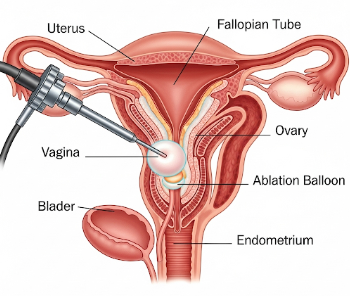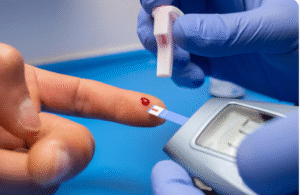Overview
Hysteroscopic endometrial ablation is a minimally invasive procedure to remove or destroy the lining of the uterus (endometrium). It is primarily performed to treat heavy menstrual bleeding (menorrhagia) when medications or other conservative therapies are ineffective.
South Korea is renowned for advanced gynecologic technology, expert surgeons, and precise hysteroscopic techniques, making it a preferred destination for women seeking safe, effective, and quick treatment for abnormal uterine bleeding.
What is Hysteroscopic Endometrial Ablation?
Hysteroscopic endometrial ablation involves:
- Insertion of a hysteroscope (thin, lighted telescope) through the vagina and cervix into the uterus
- Visual assessment of the uterine cavity for abnormalities
- Destruction or removal of the endometrial lining using thermal energy, radiofrequency, or laser techniques
- Minimally invasive procedure → No abdominal incisions required
Indications include:
- Heavy menstrual bleeding not responsive to medication
- Benign uterine conditions like polyps or hyperplasia (non-cancerous)
- Women who do not desire future fertility (pregnancy is contraindicated after the procedure)
What are the Benefits?
- Minimally invasive with no abdominal incisions
- Short procedure time → Typically 20–60 minutes
- Quick recovery → Most patients resume normal activities within 1–2 days
- Significant reduction or cessation of menstrual bleeding
- Outpatient procedure → Often performed without overnight hospitalization
- High patient satisfaction in Korea due to precision and post-procedure care
- Low complication rates compared to more invasive surgeries
Procedure Details
1) How should I prepare for Hysteroscopic Endometrial Ablation?
- Preoperative evaluation → Blood tests, pelvic ultrasound, and assessment of uterine size and abnormalities
- Medication instructions → Avoid blood thinners or certain medications as advised
- Fasting → Usually 6–8 hours if general anesthesia is used
- Pre-procedure consultation → Discuss type of ablation, anesthesia, expected results, and risks
- Infection prevention → Sometimes a prophylactic antibiotic may be prescribed
2) What happens during the procedure Hysteroscopic Endometrial Ablation?
- Anesthesia → Local, regional, or general anesthesia depending on patient and technique
- Insertion of hysteroscope → Through the cervix into the uterine cavity
- Endometrial destruction → Techniques include:
- Thermal balloon ablation
- Radiofrequency ablation
- Laser ablation
- Electrosurgical resection
- Duration → 20–60 minutes depending on technique and uterine anatomy
- Monitoring → Vital signs continuously observed during the procedure
3) What happens after Hysteroscopic Endometrial Ablation?
- Recovery room → Patient monitored until fully awake if general anesthesia used
- Post-procedure care → Mild cramping, spotting, or discharge may occur for a few days
- Activity restrictions → Avoid heavy lifting, sexual activity, or tampon use for 1–2 weeks
- Pain management → Over-the-counter analgesics for mild discomfort
- Follow-up visits → Assess bleeding reduction and uterine healing
Risks / Benefits
Risks
- ➤ Cramping, spotting, or discharge for several days
- ➤ Infection of the uterus (rare)
- ➤ Perforation of the uterus (rare, may require further surgery)
- ➤ Heavy bleeding (rare)
- ➤ Unsatisfactory results → Some patients may still have bleeding or require repeat procedure
Benefits
- ➤ Minimally invasive with no abdominal incisions
- ➤ Short procedure and rapid recovery
- ➤ Significant reduction or cessation of heavy menstrual bleeding
- ➤ High satisfaction and low complication rates in expert Korean centers
- ➤ Outpatient or short-stay procedure
Recovery and Outlook
- Immediate recovery → Mild cramping, light bleeding, or watery discharge for a few days
- Return to normal activity → Usually within 1–2 days
- Follow-up care → Monitor menstrual bleeding, signs of infection, and overall satisfaction
- Long-term outlook → Most women experience significant improvement in menstrual bleeding within 2–3 months
- Fertility considerations → Pregnancy is not recommended after endometrial ablation
- Repeat procedures → Rarely, additional treatment may be required if bleeding persists
South Korea provides expert post-procedure care, including follow-up consultation, patient education, and management of complications, ensuring optimal outcomes and satisfaction.
When To Call the Doctor
Contact your doctor immediately if you notice:
- ⚠️ Heavy or prolonged bleeding
- ⚠️ Fever, chills, or signs of infection
- ⚠️ Severe pelvic or abdominal pain not relieved by medication
- ⚠️ Foul-smelling vaginal discharge
- ⚠️ Dizziness or fainting due to blood loss
Best Korea Option / Process
South Korea is a leading destination for hysteroscopic endometrial ablation due to:
- Highly skilled gynecologists and minimally invasive specialists
- State-of-the-art hysteroscopic equipment
- Outpatient and short-stay treatment options
- Comprehensive post-procedure care and follow-up
- International patient coordination, including translation and hospital support
Top Hospitals for Hysteroscopic Endometrial Ablation in Korea:
- Asan Medical Center, Seoul – Expertise in minimally invasive gynecology
- Samsung Medical Center – Advanced hysteroscopic techniques for uterine conditions
- Seoul National University Hospital (SNUH) – Comprehensive outpatient care and follow-up
- Yonsei Severance Hospital – High patient satisfaction with minimally invasive gynecologic procedures
👉 For women with heavy menstrual bleeding not responsive to medications, Hysteroscopic Endometrial Ablation in Korea offers a safe, minimally invasive, and highly effective solution with rapid recovery and excellent outcomes.













